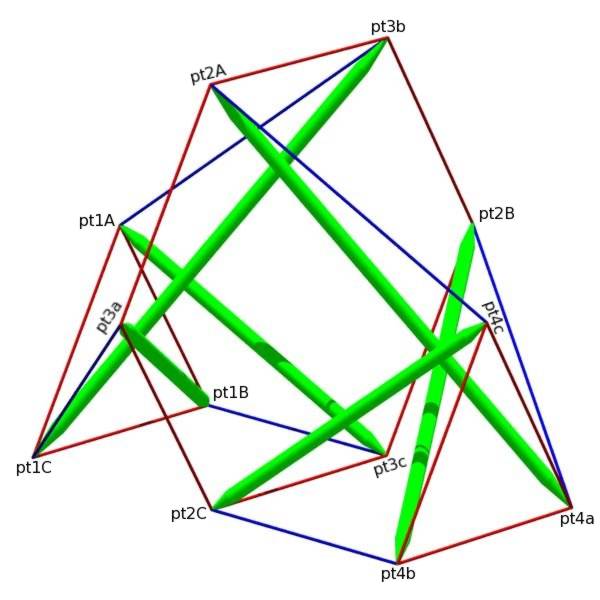
Structure Based on Laminated Skew Prisms with Point Labels
structure file: mast/x3l2mast2b.rc
variable file: mast/x3l2mast2b.dat
digit list: src/mm.dls
|
Member Descriptions
[name, end point names, weight (if in objective function),
second power of length (if a constraint), member category,
Obj/Con/Exc (put in objective function, use as a constraint or
exclude from computations), flags]
For assembly purposes, only the name and end point names are
of interest. The other information may be of interest after
A Practical Guide to Tensegrity Design has been consulted.
<Member> strut13a pt1A pt3c -1.0 2.0 1 Con *
<Member> strut24a pt2A pt4a -1.0 5.0 1 Con *
<Member> end1a pt1A pt1B 1.0 sqr(1.0) 2 Con *
<Member> end2a pt4a pt4b 1.0 sqr(1.0) 2 Con *
<Member> guy1a pt1A pt3b 1.0 sqr(1.0) 3 Obj *
<Member> guy2a pt2C pt4b 1.0 sqr(1.0) 3 Obj *
<Member> eq1a pt2A pt3a 1.0 sqr(1.0) 2 Con *
<Member> eq2a pt2A pt3b 1.0 sqr(1.0) 2 Con *
<Member> strut13b pt1B pt3a -1.0 4.0 1 Con *
<Member> strut24b pt2B pt4b -1.0 4.0 1 Con *
<Member> end1b pt1B pt1C 1.0 sqr(1.0) 2 Con *
<Member> end2b pt4b pt4c 1.0 sqr(1.0) 2 Con *
<Member> guy1b pt1B pt3c 1.0 sqr(1.0) 3 Obj *
<Member> guy2b pt2A pt4c 1.0 sqr(1.0) 3 Obj *
<Member> eq1b pt2B pt3b 1.0 sqr(1.0) 2 Con *
<Member> eq2b pt2B pt3c 1.0 sqr(1.0) 2 Con *
<Member> strut13c pt1C pt3b -1.0 5.0 1 Con *
<Member> strut24c pt2C pt4c -1.0 2.0 1 Con *
<Member> end1c pt1C pt1A 1.0 sqr(1.0) 2 Con *
<Member> end2c pt4c pt4a 1.0 sqr(1.0) 2 Con *
<Member> guy1c pt1C pt3a 1.0 sqr(1.0) 3 Obj *
<Member> guy2c pt2B pt4a 1.0 sqr(1.0) 3 Obj *
<Member> eq1c pt2C pt3c 1.0 sqr(1.0) 2 Con *
<Member> eq2c pt2C pt3a 1.0 sqr(1.0) 2 Con *
In-Situ Member Lengths
These are the lengths of the members when they are in place
and prestress is applied. The strut lengths are from pin insertion
point to pin insertion point, as are the tendon lengths.
The values are in model units.
strut13a: 1.41421 strut24a: 2.23607 end1a: 1
end2a: 1 guy1a: 1.41421 guy2a: 1
eq1a: 1 eq2a: 1 strut13b: 2
strut24b: 2 end1b: 1 end2b: 1
guy1b: 1 guy2b: 1.41421 eq1b: 1
eq2b: 1 strut13c: 2.23607 strut24c: 1.41421
end1c: 1 end2c: 1 guy1c: 1.41421
guy2c: 1.41421 eq1c: 1 eq2c: 1
Relative Member Force Magnitudes
These values are useful for developing an assembly
strategy for the structure. The tighter tendons are much
easier to tie in place early on, while the looser tendons
can be left to the last. This information is also used
to adjust tendon lengths since the measured length of a tendon
will be shorter for a highly-stressed tendon with the same
in-situ length as a tendon which is not so stressed.
strut13a: -1.41421 strut24a: -2.23607 end1a: 1
end2a: 1 guy1a: 1.41421 guy2a: 1
eq1a: 1 eq2a: 1 strut13b: -2
strut24b: -2 end1b: 1 end2b: 1
guy1b: 1 guy2b: 1.41421 eq1b: 1
eq2b: 1 strut13c: -2.23607 strut24c: -1.41421
end1c: 1 end2c: 1 guy1c: 1.41421
guy2c: 1.41421 eq1c: 1 eq2c: 1
Average tendon force magnitude: 1.09205
Construction Lengths (in millimeters and halves)
The construction length of a tendon is less than the in-situ
length since when the tendon is measured off it isn't under
any prestress force. The construction length for the strut
represents the length of the 3/16-inch-diameter wooden dowel.
The tendons were made of 12-lb.-test braided nylon fishing line.
In this case, the attachment point at the hubs was a simple
metal pin stuck into the end of the strut, so no member-length
adjustments were necessary. Prestress forces are assumed
not to affect strut lengths.
Elongation of Tendon of Unit Cross Section
Under Force of Average Magnitude (fraction)> .02
Length Scale Factor> 88/sqrt(2)
Strut and Tendon Hub Adjustments - s;t> 0 0
strut13a: 88 0 strut24a: 139 0 end1a: 61 0 end2a: 61 0
guy1a: 86 0 guy2a: 61 0 eq1a: 61 0 eq2a: 61 0
strut13b: 124 1 strut24b: 124 1 end1b: 61 0 end2b: 61 0
guy1b: 61 0 guy2b: 86 0 eq1b: 61 0 eq2b: 61 0
strut13c: 139 0 strut24c: 88 0 end1c: 61 0 end2c: 61 0
guy1c: 86 0 guy2c: 86 0 eq1c: 61 0 eq2c: 61 0
Material Quantities (in millimeters)
Estimates of the total amount of material required to build
the structure. The adjustment in this case includes "waste":
for the strut, the amount lost when sawing the strut from a
length of dowel (1 mm from each end); for the tendons, the amount
of extra needed to successfully tie the tendon (50 mm extra at
each end).
Elongation of Tendon of Unit Cross Section
Under Force of Average Magnitude (fraction)> .02
Length Scale Factor> 88/sqrt(2)
Strut and Tendon Adjustments - s;t> -1, -50
Cross
Type Section Quantity Count
1 1 715.182 6
2 1 1911.69 12
3 1 1051.63 6
Strts 715.182 6
Tndns 2963.32 18

Structure Based on Laminated Skew Prisms with Point Labels
structure file: mast/x3l2mast2b.rc
variable file: mast/x3l2mast2b.dat
digit list: src/mm.dls
|
|
CONTACT: Bob Burkhardt Tensegrity Solutions Box 426164 Cambridge, MA 02142-0021 USA e-mail: bobwb@juno.com |
Back to
Structure Based on Laminated Skew Prisms
More Datasheets